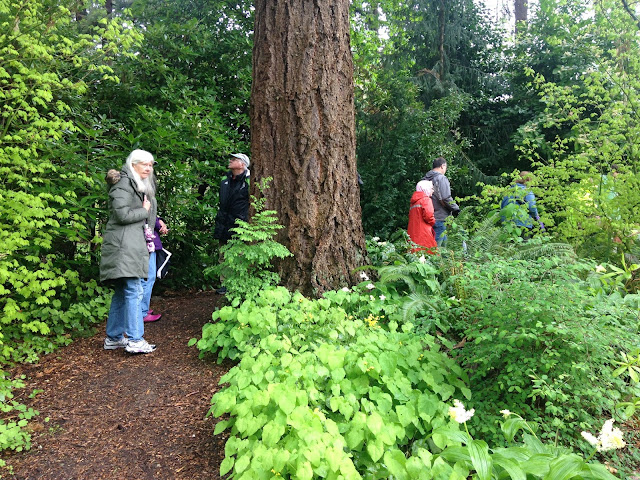On Saturday we returned to this lovely garden after our previous visit several years ago, this time with our garden group. The light rain and dull skies made for a fresh garden and for good photography.
About the Gardens
The esteemed Olmsted Brothers Landscape firm designed the Dunn Gardens in 1915. One hundred years later the vision of the Gardens as a place of timeless grace has been realized. Notable features include naturalistic groupings of trees, broad lawns with borders of shrubs, and woodland walks. Plants range from diminutive erythroniums to large rhododendrons and towering Douglas firs.
Getting the history from our tour guides in the visitor room, which is the sun room of one of three houses on the property. Family members still live in the other two.
With the towering trees and old rhododendrons overhead, is is easy to miss the abundance of plant life on the ground level, but to me it is where most of the magic is, especially in spring, when plants emerge and spring ephemerals put on their show before fading away.
A very well placed glass installation.
Many of the herbaceous plants are natives, like the False Solomon's Seal with its frothy blooms.
Garden maintenance is on-going, and many of the beds have recently been reworked, so new plants, like these hellebores, have been added, while natural ground cover like the oxalis and the fringe cup are encouraged.
A lovely pink erythronium, or Fawn Lily or Avalanche Lily, depending whether they are growing on a stream side or a mountain meadow, set against the leaves of a Himalayan lily. That's the big and the small of herbaceous plants. The lily, a Cardiocrinum giganteum, will tower up to twelve feet high when it blooms in the seventh year of its life.
There are many different varieties of trillium in this garden
There are also many varieties of Epimediums, each with distinctive leaf shapes and delicate little flowers in early spring. While the flowers are delicate looking, these plants are tough, thriving in dry shade under big trees.
The summer house, rebuilt from the original, and still a private Dunn family residence, at the head of the great lawn. A yellow magnolia
White, native erythronium.
This property was logged off when the Dunn first bought it, so the trees here were planted in 1915. Hundred year old Douglas Firs are majestic.
This arbor is really a hundred year old Magnolia stellata.
Old Beech trees are typical of Olmstead gardens.
The story is that Mrs. Dunn didn't like taking care of the roses that were originally here, so she had heather planted instead.
The Woodland Walk, along one side of the Great Lawn.
The tennis lawn, now an event site.
Back at the Caretakers Cottage/Visitors Center there is a remarkable garden surrounding the back terrace. These old moss covered fern hummocks were quite fascinating.
More epimediums.
Since it was raining, I came with my small Canon camera. Unfortunately I also had an almost dead battery and the spare was also dead, not my finest hour as a photographer. I then switched to my iPhone 5, which is not the best of cameras, but serviced. Then it told me that my memory storage was full, so, perhaps to your relief, I gave up and just enjoyed the experience as we toured Arthur's Garden on the other side of the property,
With the rain let up, and robins chirping their delight, we walked on moss and under towering trees and blooming shrubs, and I soaked it all in and sighed with pleasure.
I hope you enjoyed your tour, and if you live anywhere near Seattle, you really should try to visit this garden in spring.



































































